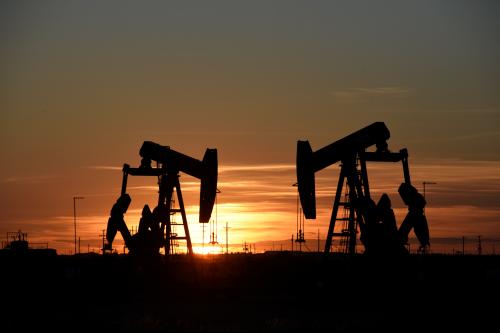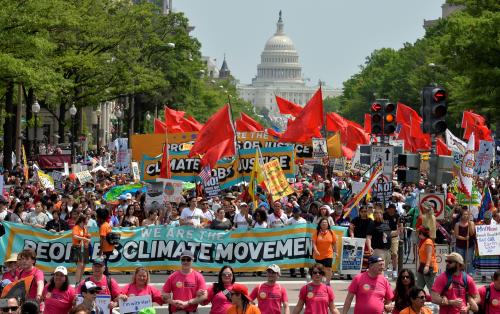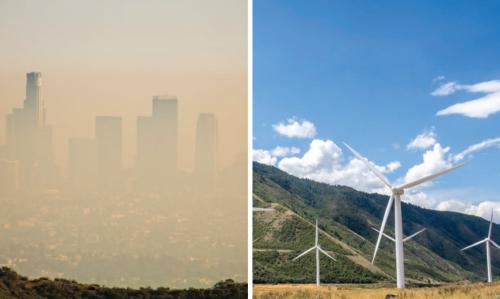Climate change is clearly one of the most important challenges of our time, but the politics of climate policy in the United States is difficult. The two parties are polarized on the issue—many Republicans, including our current president, deny the existence of the problem while the Democrats running to replace him in the 2020 election are proposing extremely ambitious goals for reducing U.S. greenhouse gas (GHG) emissions. Achieving net-zero emissions by 2050 or sooner, as advocated by many of the Democratic candidates, is consistent with avoiding the worst impacts of climate change. However, the world and the United States are not currently on a path to achieve this level of reduction.
Adding to the challenge, U.S. oil and natural gas production has soared in the past decade. The United States is now the world’s leading producer of both oil and natural gas. This trend has brought about numerous economic benefits, including job creation, improvement in the balance of trade, and greater competitiveness for certain industries. However, GHG emissions from fossil fuels are the primary driver of climate change. The world needs to transition away from fossil fuels, at least those burned without carbon capture and storage.
A number of Democratic presidential candidates are proposing to limit U.S. fossil fuel production as a way of combatting climate change, through eliminating oil and gas production on public lands or banning hydraulic fracturing, a technology central to the U.S. production boom. Such policies make sense at first glance given that the United States is making an important contribution to the problem through its domestic oil and gas production. Eliminating that production seems like a good way to eliminate emissions.
Yet cutting back domestic oil and gas production without an equally ambitious focus on demand will just increase U.S. imports, rather than reduce consumption. The United States could lose the economic advantages of its oil and gas production without a commensurate reduction in GHG emissions. In fact, such an outcome could actually increase global emissions, depending on how replacement fuels are produced and the emissions produced in transporting them to the United States. We must remember that climate change is a global problem and that the measure that matters is global GHG emissions. Any “solution” that reduces U.S. emissions, but increases global emissions, is no solution at all. Fossil fuel companies are a politically expedient enemy, but the hard work of actually reducing GHG emissions requires a focus on nearly every sector of the economy.
I propose that the United States enact policies that reduce the use of fossil fuels without carbon capture and storage, ensure that oil and gas produced in the United States have the lowest GHG emissions possible, and prepare for the eventual decline of domestic oil and gas production through policies that will help affected communities through the transition. I’m not advocating for less ambitious climate policy, but for policy that focuses its efforts on the demand and emissions side of the ledger. Our government should let economics determine how much oil and gas is produced in the United States. When demand-focused policies, like a carbon tax or efficiency standards, make U.S. fuels uncompetitive, their production will naturally decline. Falling costs for renewable energy are helping to push fossil fuels out of electricity generation, but oil and gas are harder to replace in other uses. Policy and research will be needed to encourage the transition in the most challenging sectors.
The United States has a unique opportunity to lead the world not only in reducing GHG emissions, but in leveraging a dynamic energy industry in the process. This paper describes how to do just that.
The case for continuing U.S. oil and gas production
Eliminating U.S. oil production faster than U.S. demand declines would result in additional oil imports. (The United States has so much natural gas production and resources that large-scale natural gas imports are difficult to imagine.) Oil is a fungible commodity, produced in countries around the world with varying levels of environmental standards and GHG emissions.
Upstream emissions from oil and gas—those that occur in production, transportation, and refining—vary greatly across sources of crude oil. The highest 10% of production in terms of GHG emissions has emissions more than 4 times those of the lowest 10%. The U.S. average crude oil, at 89 kilograms of carbon dioxide equivalent per barrel (kg CO2e/bbl), has lower upstream emissions than the global average of 95 kgCO2e/ bbl.1 These distinctions are small when one considers the challenge of deep decarbonization, but as the world strives to reduce emissions overall, using the lowest-emissions sources of crude oil can help.
One could argue that reducing U.S. oil and gas production would increase global oil and gas prices and thus decrease their use globally. This might be true for a while, but the global oil market has a history of strong price swings, as high prices bring out more production that sends prices crashing down again. It’s unlikely that decreased U.S. production would keep prices high enough for long enough to significantly decrease global demand.
Climate change and GHG emissions are global problems—the measure that matters is global emissions, no matter where in the world they occur. Moving production and re-arranging markets to reduce the emissions within or attributable to the United States doesn’t help if we merely export those emissions to other places.
Actions to take in the United States
The United States can get serious about climate change as the world’s largest oil and gas producer by involving energy companies in the transition, regulating oil and gas production to minimize GHG emissions, and enacting policies that reduce GHG emissions at home and abroad.
Include energy companies in the low-carbon transition
Vilifying all fossil fuel companies is likely to be counterproductive. Clearly some companies are more constructive in their climate strategies than others; misinformation campaigns have no place in today’s political debate. Some companies have more to lose or gain in a low-carbon world. Nonetheless, many fossil fuel companies understand that climate change is an existential risk to their business model and want to remain viable businesses as the world moves toward a low-carbon energy system. The comparison of fossil fuel companies to tobacco companies is particularly frustrating. Unlike tobacco, the modern economy was built on fossil fuels, and replacing them and the trillions of dollars of associated infrastructure will take time.
I am not saying that we should turn climate policy over to the industry, but instead recognize that energy companies have a role to play in the energy transition. For example, some skills and technologies developed in the oil and gas industry are also useful in clean energy, such as offshore construction skills applied to offshore wind energy or knowledge of the subsurface applicable to geothermal energy production and carbon storage. The skill necessary to operate and balance an electricity grid will become ever more important as the share of intermittent renewable power generation increases. The energy industry has extensive experience in financing and developing large, long-lived projects. Energy companies are repositories of the knowledge needed to achieve a clean energy transition and eliminating them from the process because of a misguided notion of “purity” could do more harm than good.
Strictly regulate U.S. oil and gas production
Regulation of U.S. oil and gas production is crucial for the United States to reduce its GHG emissions. Overall regulation of the industry must consider local air and water pollution and community impacts, but two areas are particularly important for the climate—methane emissions and flaring.
Methane is the primary component of natural gas. However, when it is emitted into the atmosphere, it is a particularly potent GHG, with 28 to 36 times the warming power of carbon dioxide, although with a much shorter lifetime in the atmosphere.2 Minimizing methane releases is one of the most important things we can do in the short term to slow climate change.
Natural gas is the lowest-carbon fossil fuel—it can have climate benefits when substituted for higher-carbon fuels like coal or oil. Its lower carbon content also makes carbon capture and storage easier, a useful quality as the world strives for deeper decarbonization. The low cost of U.S. gas production has greatly reduced coal use in the U.S. power sector, with important climate benefits. The United States is also a net exporter of natural gas, through pipelines and liquefied natural gas (LNG), and in many cases this exported gas substitutes for higher-carbon fuels abroad. However, these climate benefits disappear if too much methane is emitted during the production, processing, transportation, and use of the gas.
Methane emissions are particularly concerning at the wellhead when the gas is produced. Advancing technology has made it easier and cheaper to identify leaks, but the current administration is in the process of rolling back Obama-era rules requiring leak detection and repair and other technologies to reduce methane emissions during production. Five oil- and gas-producing states (California, Colorado, Ohio, Pennsylvania, and Wyoming) have methane emissions regulations of their own and New Mexico is in the process of developing regulations. However, other important oil and gas states, notably including Texas, lack methane emissions regulations. Federal rules for leak detection and repair throughout the natural gas value chain are needed to ensure that natural gas fulfills its promise as the lowest-carbon fossil fuel.
Flaring is another avoidable source of GHG emissions in oil and gas production. Natural gas is often produced along with oil, but in some cases there is neither infrastructure nor economic incentive to transport the gas away from the well for sale. In these cases, the gas is burned, or flared, at the wellhead. (Flaring is safer and better from a climate perspective than releasing the gas directly, as it converts methane to carbon dioxide, a much less potent GHG.) Natural gas prices are very low in the United States and natural gas infrastructure has not kept up with the rapid expansion of oil production in some areas, resulting in a 50% increase in flaring in 2018 compared to the previous year.3 U.S. producers are making their money from oil, and in some cases the associated gas is not worth enough to justify shipping it to market. However, flaring all this gas is terribly wasteful. In Texas in 2019, enough gas was flared to meet residential natural gas demand within the entire state. Flaring is regulated at the state level and Texas has never turned down a request to flare.4 However, the United States must eliminate routine gas flaring to reduce its GHG emissions and avoid wasting fuel. Regulators can require that wells be connected to gas infrastructure before production is allowed, even if the economics do not justify shipping the gas to market.
Increasing capacity to export LNG could help in this regard, by providing an outlet for plentiful U.S. natural gas to be sold abroad, rather than wastefully burned here.
Enact policies to reduce GHG emissions at home and abroad
To prevent the worst impacts of climate change, the United States must reduce GHG emissions across the entire economy. A number of policies will likely be needed, as the challenges are different in different sectors. My Voter Vital on climate change summarizes potential policies, from carbon taxes to encouraging the use of alternative fuels to direct regulation of emissions.
The important point here is the emphasis on reducing emissions. Policies that reduce demand for fossil fuels must focus on reducing GHG emissions as well. For example, U.S. policies that require blending corn ethanol into gasoline reduce oil demand, but have a negligible impact on GHG emissions. We must focus on the root cause of the problem.
Because fossil fuels are widely used and traded globally, reducing U.S. domestic supply is unlikely to have much effect on global GHG emissions. However, the United States is the world’s second largest GHG emitter and 77% of U.S. GHG emissions come from fossil fuel combustion.5 Significantly reducing U.S. demand for fossil fuels, and eventually eliminating their combustion without carbon capture and storage or use, is an action that will move the needle on climate change. Strong and consistent climate policy will also send the right signal to the energy industry to shape its future investments.
The United States can also provide leadership and technical assistance to help other countries transform their energy systems and reduce GHG emissions. The United States can end its own subsidies for fossil fuel production and consumption and help other countries do the same. A transition to lower-carbon energy in the United States and other wealthy countries can create markets and economies of scale for low-carbon technologies, bringing down costs for all, as Germany is working to do with its Energiewende. U.S. laboratories and universities are the envy of the world and research undertaken here can provide solutions to global challenges. Finally, the Paris Agreement includes the goal of “making finance flows consistent with a pathway towards low greenhouse gas emissions and climate-resilient development.”6 The United States can provide direct assistance to countries that need it, perhaps by returning to its commitment to provide an additional $2 billion to the Green Climate Fund. Furthermore, the deep and liquid U.S. capital markets might be even more important in providing a source of financing, especially as U.S. investors look for greener investments.
The United States can be a leader in improving, then winding down fossil fuel production
The United States has an opportunity to lead the world in improving the performance of the fossil fuel sector and in winding down the sector when the time comes. Transforming the global energy sector, with its trillions of dollars of associated infrastructure, will take time. Some uses of fossil fuels, such as in heavy transportation and industry, may never be phased out and instead their emissions may be captured or offset. In the meantime, the United States can demonstrate how to produce fossil fuels as cleanly as possible and encourage other producers to do the same. The United States can also work toward greater accountability for GHG emissions in oil and gas production.
Eventually, U.S. oil and gas production will decline as global demand for these fuels declines. U.S. production is competitive at today’s demand and price levels, but the United States does not produce the cheapest or lowest-GHG oil and gas—that distinction belongs to producers in the Middle East. At some point, U.S. oil and gas will no longer be competitive in a lower-carbon world.
A key action for the United States should be to work with the communities most affected by the upcoming decline—those where fossil fuels are currently produced. Communities will need economic development to replace the revenue and jobs that fossil fuels provide. Large industries have come and gone in our country before; we must learn from past experiences to lessen the impacts of the energy transition on those with the most to lose and orient economic development toward new industries. A transition is already occurring today in communities reliant on coal, and the trend will continue over time as the economy uses less oil and gas. Convincing citizens that the transition to a lower-carbon economy will be fair and just will help create the political imperative for action.
-
Footnotes
-
International Energy Agency, “Innovation and the environmental performance of oil and gas supply,” in World Energy Outlook
2018, OECD Publishing, Paris, https://doi.org/10.1787/weo-2018-14-en.
IHS Markit, “Greenhouse gas intensity of oil sands production, today and in the future,” September 2018. -
The United States Environmental Protection Agency, “Greenhouse Gas Emissions: Understanding Global Warming Potentials,”
The United States Environmental Protection Agency,
https://www.epa.gov/ghgemissions/understanding-global-warming-potentials -
Morgan Bazilian and Joshua Busby, “The United States’ Gas Flare-Up,” Foreign Policy, July 28, 2019, https://foreignpolicy.
com/2019/07/28/the-united-states-gas-flare-up/ - Ryan Collins, “Texas Oil Regulator Shifts Stance on Gas Flaring,” Bloomberg, https://www.rigzone.com/news/wire/texas_oil_regulator_shifts_stance_on_gas_flaring-09-aug-2019-159527-article/
-
The United States Environmental Protection Agency, “Inventory of U.S. Greenhouse Gas Emissions and Sinks 1990-2017,”
The United States Environmental Protection Agency, https://www.epa.gov/sites/production/files/2019-04/documents/us-ghginventory-2019-main-text.pdf - https://unfccc.int/sites/default/files/english_paris_agreement.pdf#page=5
-
International Energy Agency, “Innovation and the environmental performance of oil and gas supply,” in World Energy Outlook
2018, OECD Publishing, Paris, https://doi.org/10.1787/weo-2018-14-en.
IHS Markit, “Greenhouse gas intensity of oil sands production, today and in the future,” September 2018.
The United States Environmental Protection Agency,
https://www.epa.gov/ghgemissions/understanding-global-warming-potentials
com/2019/07/28/the-united-states-gas-flare-up/
The United States Environmental Protection Agency, https://www.epa.gov/sites/production/files/2019-04/documents/us-ghginventory-2019-main-text.pdf










